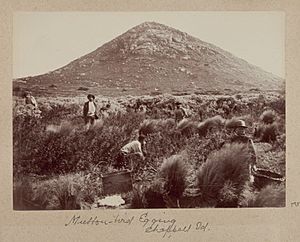Muttonbirding facts for kids
Muttonbirding is when people collect young birds called petrels, especially a type called shearwaters. They do this at certain times of the year. People collect these young birds for food, oil, and their feathers. This has been happening for a very long time, even before history was written down!
Sometimes, too much hunting caused some bird groups to disappear. But today, muttonbirding in Australia and New Zealand is usually done in a controlled way. This helps make sure there are still enough birds for the future.
In Australia, people mostly collect young short-tailed shearwaters. These birds are also known as yollas or Australian muttonbirds. You can find them in Bass Strait, near Tasmania. In New Zealand, people collect young sooty shearwaters. These are called titi or New Zealand muttonbirds. They live on small islands around Stewart Island.
Muttonbirding in Australia
People in Tasmania, Australia, have been collecting young short-tailed shearwaters for a long time. This was a traditional way for Tasmanian Aborigines and early European settlers to get food.
Official collecting, with special permits, started in 1903. However, by the late 1900s, fewer people were buying the birds. Also, younger indigenous people in the Furneaux Group of islands were less interested in continuing the tradition. This caused the amount of muttonbirding to go down.
Muttonbirding in New Zealand
In New Zealand, the collecting of young sooty shearwaters is managed by Māori from Rakiura. This happens on 36 islands known as the Titi or Muttonbird Islands. These islands are found around Rakiura (Stewart Island).
About 250,000 young birds are collected each year. There is proof that this collecting has been going on since at least the 1600s. It is an important part of Māori culture and food traditions.
What are Muttonbirds?
The name "muttonbird" can refer to different kinds of seabirds. Most often, it means petrels from the Puffinus group, which are also called shearwaters. Young birds are taken by hand from their underground nests before they can fly. They are collected for food and oil.
The name "muttonbird" first came from settlers on Norfolk Island. They thought the meat of these birds tasted strong and fatty, like mutton (sheep meat). Others have said the taste is more like fish or seafood.
Here are some types of birds that are called muttonbirds:
- Short-tailed shearwater: This seabird nests in south-eastern Australia. Many nest on the Furneaux Group of islands in eastern Bass Strait.
- Sooty shearwater: This seabird nests mainly in New Zealand and on islands in the South Atlantic Ocean.
- Wedge-tailed shearwater: You can find this bird in warm and mild parts of the Indian and Pacific Oceans.
- Manx shearwater: This bird breeds in the North Atlantic area. People used to collect them a long time ago.
- Cape Verde shearwater: This bird breeds in the Cape Verde islands in the Atlantic Ocean. Its numbers have gone down because too many were collected.
- Grey-faced petrel (Pterodroma gouldi)
- Providence petrels: These birds were collected so much on Norfolk Island that they disappeared there in the early 1800s. They still live on Lord Howe Island. People used to call them 'muttonbirds' or 'flying sheep'.


